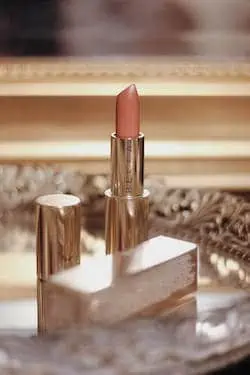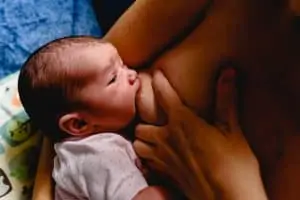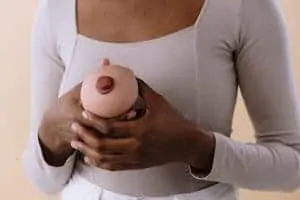Breastfeeding can be hard on your nipples, and they can undergo rapid changes. Some changes can make it feel like breastfeeding isn’t going so well, and other changes are purely cosmetic. One of those changes is when you might have a lipstick nipple while breastfeeding.
When you first notice it, you might be confused or worried. Is it a problem? Should you be concerned? Most of all, you’ll wonder if you can fix a slanted nipple.
The answer is yes! If you have a slanted nipple, you can fix it. Here’s what you need to know.
What Is a Lipstick Nipple?

You’ll notice a lipstick nipple after breastfeeding when your nipple comes out of your baby’s mouth with a flattened appearance. It looks like the slanted side of a new lipstick tube, which is why it’s often called a slanted nipple.
This means that your baby’s latch isn’t deep enough, which can cause concern, but having a lipstick-shaped nipple after breastfeeding is typically a painless problem. We can be thankful that it doesn’t cause any pain, but it does need to be fixed.
Why is a Lipstick Nipple a Problem?
When you discover that your nipple looks like a tube of lipstick, you don’t have a deep enough latch, which can cause problems over time. A bad latch can cause several issues, such as:
- Insufficient Milk Supply
- Shallow Latch (leads to painful nipples)
- Slow Growth
- Failure to Thrive – worst-case scenario
While a lousy latch or two is rarely problematic, a consistently bad latch will cause issues with your baby correctly transferring milk from the breast. Over time, that will cause your child to have growth problems, which is the last thing you want.
So, when you see a lipstick nipple after nursing your baby each time, it means something needs to be done.
How to Fix a Lipstick Nipple
The key to fixing the problem is getting a deep latch each time you breastfeed your baby. It helps to be skin-to-skin with your baby, but that’s not always possible. It does, however, encourage your baby’s natural feeding instincts and promote a deeper latch.
Here’s how to get your baby to latch deeply. It’s not as hard as it seems.
- Support your baby. Keep your hand between your baby’s shoulder and your fingers at the base of your baby’s head.
- Use your other hand to hold your breast, using your thumb and fingers to form a C. However, make sure you keep your fingers away from the nipple.
- Make sure your baby is turned towards you, and his head should be faced forward with his chin slightly tilted upwards.
- Your nipple should be facing your baby. To encourage your baby to latch deeply, use your hand to point your nipple toward your baby’s nose. He will naturally lift his chin and open widely.
- Aim your breast towards the roof of your baby’s mouth, and let him latch onto the breast.
How to Know if You Have a Good Latch
Some babies are tricky, and it will sound like they are drinking and often swallowing, so that’s not the best indicator for the proper latch. You know that your baby has a solid latch if:
- His chin touches the breast first.
- The bottom lip should be out further from the base of the nipple than the top lip. His lips should be curled outward.
- His nose might touch the breast, but your baby should be able to breathe from both sides.
Get The Right Latch
Finding out that you have a lipstick nipple can be upsetting; you’re recovering from childbirth, and the last thing you want to do is deal with breastfeeding problems. If you work on getting the perfect latch with your baby, any issues you might have had with a lipstick-shaped nipple will go away.
Hey, this is Linda. My biggest accomplishment in life is being a mother of four children. Their current ages range from almost ten years old down to 20 months old.
I’m passionate about writing parenting articles because I understand so well all of the problems and trials you face as a parent. From breastfeeding woes to budgeting problems and behavior problems, along with everything in between, chances are I’ve faced it over the last ten years. Read more about Linda here.






